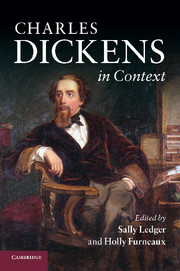Book contents
- Frontmatter
- Contents
- List of illustrations
- Notes on contributors
- Preface
- Notes on references
- PART I LIFE AND AFTERLIFE
- 1 The life of Dickens 1: before Ellen Ternan
- 2 The life of Dickens 2: after Ellen Ternan
- 3 Dickens's lives
- 4 Victorian stage adaptations and novel appropriations
- 5 Reviewing Dickens in the Victorian periodical press
- 6 The European context
- 7 Major twentieth-century critical responses
- 8 Modern stage adaptations
- 9 Modern screen adaptations
- 10 The heritage industry
- 11 Neo-Victorian Dickens
- PART II SOCIAL AND CULTURAL CONTEXTS
- Further reading
- Index
10 - The heritage industry
Published online by Cambridge University Press: 05 August 2012
- Frontmatter
- Contents
- List of illustrations
- Notes on contributors
- Preface
- Notes on references
- PART I LIFE AND AFTERLIFE
- 1 The life of Dickens 1: before Ellen Ternan
- 2 The life of Dickens 2: after Ellen Ternan
- 3 Dickens's lives
- 4 Victorian stage adaptations and novel appropriations
- 5 Reviewing Dickens in the Victorian periodical press
- 6 The European context
- 7 Major twentieth-century critical responses
- 8 Modern stage adaptations
- 9 Modern screen adaptations
- 10 The heritage industry
- 11 Neo-Victorian Dickens
- PART II SOCIAL AND CULTURAL CONTEXTS
- Further reading
- Index
Summary
In the years since Dickens first found fame as an author, his image has been used in many contexts, most suggestively as the face, for over a decade, of the Bank of England's ₤10 note. Dickens's image, like that of Charles Darwin which replaced his on the ₤10 note, was no doubt chosen to convey something of Britain's ‘greatness’, of a national heritage imparting solidity to the flimsiness of paper money. On the Dickens ₤10 note, his image is superimposed on the nostalgic, ‘inimitably English’ scene from The Pickwick Papers (1836–7): the Dingley Dell cricket match. The Dickens ₤10 note captures much about the way in which Dickens's image has been used posthumously by the heritage industry: the note works to promote an association between Dickens and an idea of Englishness that combines cosy communality with reminders of the ‘greatness’ of Britain's past.
The phrase ‘the heritage industry’ was coined by Robert Hewison in his work of that name, and is widely used to refer to the heritage sector in the twentieth and twenty-first centuries. However, the idea of the Victorians as self-conscious engineers and pioneers of a political and commercial sense of national and international ‘heritage’ is widely accepted. John Gardiner has written in engaging terms about the ways in which the Victorians, notably Queen Victoria, ‘anticipated twentieth-century observers in their attitude to heritage’; his description of Victoria's servants as going through a ‘dress rehearsal for the “heritage industry” of today’ is more widely applicable to the role of Victorians in the evolution of the heritage industry.
- Type
- Chapter
- Information
- Charles Dickens in Context , pp. 74 - 80Publisher: Cambridge University PressPrint publication year: 2011
- 1
- Cited by



